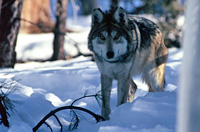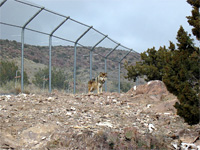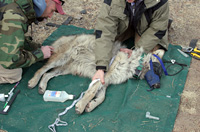Reestablishing The Population

Photo Courtesy of the U.S. Fish and Wildlife Service
All wolves in the program are descendants of seven wolves. Five of the seven were wild-caught in Mexico before 1980, and two were selected from captive populations. Today’s captive breeding program includes more than 300 wolves in 47 zoos and sanctuaries across the United States and Mexico.
Balancing Act
Managing reintroduced Mexican wolves is a continual balancing act between increasing the number of wolves and protecting the interests of people.
Starting from Scratch
There were no wild Mexican wolves in the United States when the Species Survival Plan was implemented in 1977. To begin the breeding program, five wild wolves were captured in Mexico and two genetically suitable wolves were located in captivity. All seven were taken into the captive breeding program and are the “founders” of the current Mexican gray wolf population.

Photo Courtesy of the U.S. Fish and Wildlife Service
The captive breeding program consists of more than 300 wolves in 47 facilities across the U.S. and Mexico. The program is the only source of Mexican wolves available to re-establish the population in the United States. Wolves identified for potential release are first sent to one of three pre-release sites: Sevilleta (shown at right) and Ladder Ranch Wolf Management Facilities in New Mexico and Wolf Haven International in Washington state.

Photo Courtesy of the Mexican Wolf Interagency Field Team
Other than contact to monitor health, human contact with wolves is limited at the pre-release facilities. Wolves are evaluated and selected for release based on genetic makeup, reproductive performance, behavior, health, and overall response to the adaptation process. The genetic makeup of each Mexican gray wolf is documented in a “stud book” to ensure the population represents a healthy genetic mix.
Adaptive Management Oversight Committee
- Arizona Game & Fish - Mexican Wolf Reintroduction and Management
- U.S. Fish & Wildlife Service - Mexican Gray Wolf Recovery Program
- U.S. Forest Service
- White Mountain Apache Tribe
- APHIS
- New Mexico Game & Fish
Signatory Cooperators
- Graham County, AZ
- Greenlee County, AZ
- Navajo County, AZ
- New Mexico Department of Agriculture
- Sierra County, NM